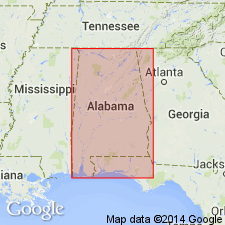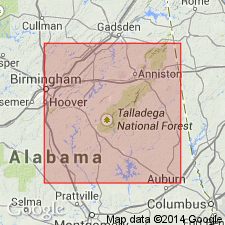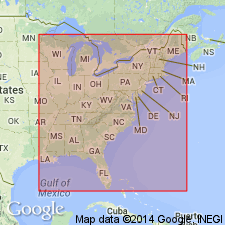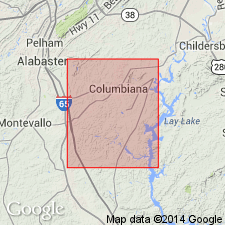
- Usage in publication:
-
- Wash Creek slate*
- Modifications:
-
- Named
- Dominant lithology:
-
- Slate
- AAPG geologic province:
-
- Piedmont-Blue Ridge province
Summary:
Wash Creek slate named in Chilton Co., central AL. Consists chiefly of slate, very similar to Waxahatchee slate, but thick interval at base is sandier than most slates of the region and has the appearance of thin-bedded sandstone. Generally contains many quartz veins. About 1,000 ft above bottom is a persistent ferruginous sandstone 130+/-ft thick. At or near top is a thick stratum of conglomeratic quartzite that may belong to Weisner formation. Thickness of formation probably 5,000 ft. Overlies Brewer phyllite and underlies Weisner formation. Age is Precambrian or Paleozoic.
Source: GNU records (USGS DDS-6; Reston GNULEX).

- Usage in publication:
-
- Wash Creek Slate
- Modifications:
-
- Revised
- AAPG geologic province:
-
- Piedmont-Blue Ridge province
Summary:
Wash Creek Slate assigned to Talladega Group in this report. Subdivided into Yellow Leaf Quartzite Schist Member, Jemison Chert Member, Cheaha Sandstone Member, Butting Ram Sandstone Member, and Jumbo Dolomite Member. Age ranges from Cambrian to Carboniferous.
Source: GNU records (USGS DDS-6; Reston GNULEX).

- Usage in publication:
-
- Wash Creek Slate
- Modifications:
-
- Revised
- AAPG geologic province:
-
- Appalachian basin
Summary:
The Kahatchee Mountain Group is here named in the southwestern part of the Talladega slate belt in AL. It is the lower structural sequence in the belt and contains the Waxahatchee Slate, Sawyer Limestone, Brewer Phyllite, and Wash Creek Slate. Underlies the Sylacauga Marble Group or the Lay Dam Formation of the Talladega Group. The Kahatchee Mountain Group may extend farther northeast and into GA. May be correlative with the Ocoee Supergroup and Chilhowee Group in the Blue Ridge belt. Age is late Precambrian and Cambrian.
Source: GNU records (USGS DDS-6; Reston GNULEX).

- Usage in publication:
-
- Wash Creek Slate
- Modifications:
-
- Revised
- Overview
- AAPG geologic province:
-
- Piedmont-Blue Ridge province
Summary:
Wash Creek Slate of Kahatchee Mountain Group consists of black to grayish-green partly graphitic slate and laminated siltstone interbedded with locally conglomeratic light-gray to light-brown arkosic metamorphosed sandstone and quartzite. Includes Kalona Quartzite Member. Age stated as late Precambrian(?) to Cambrian(?).
Source: GNU records (USGS DDS-6; Reston GNULEX).

- Usage in publication:
-
- Wash Creek Slate*
- Modifications:
-
- Overview
- AAPG geologic province:
-
- Appalachian basin
Summary:
Authors follow usage of Tull (1982) as Kahatchee Mountain Group of Talladega block in AL. [Formations not discussed separately but usage is inferred.] Base of Kahatchee Mountain is not exposed, nor are any crystalline basement rocks exposed in Talladega block in AL. To the northeast in GA, Kahatchee Mountain Group may unconformably overlie Middle Proterozoic basement (if Mulberry Rock Gneiss proves to be basement). Tull (1982) suggests that Kahatchee Mountain rocks are roughly equivalent to Ocoee Supergroup and Chilhowee Group rocks. McConnell and Abrams (1984) portray northeastern end of Talladega belt, which would be Kahatchee Mountain Group, as continuous into Great Smoky Group. More recently, archaeocyathids have been found in Jumbo Dolomite (McKinney and others, 1988), which is stratigraphically below Sylacauga Marble Group of Tull (1982) and its base is interlayered with lithologies of Kahatchee Mountain Group. Jumbo is correlated with Early Cambrian Shady Dolomite of Valley and Ridge province. The Kahatchee Mountain rocks, like Ocoee rocks, are volcanic-free.
Source: GNU records (USGS DDS-6; Reston GNULEX).

- Usage in publication:
-
- Wash Creek Slate
- Modifications:
-
- Revised
- Overview
- AAPG geologic province:
-
- Piedmont-Blue Ridge province
Summary:
In the study area, the Wash Creek Slate of the Kahatchee Mountain Group is subdivided into four members: an unnamed ferruginous sandstone member (250 ft above the base of the Wash Creek), the Hillsdale Sandstone Member (new), the Kalona Quartzite Member, and the Mount Zion Church Member (new). The Hillsdale is the most areally extensive of the four. In the southern part of the study area, the Wash Creek Slate reaches 5,988 ft in thickness. In the Sylacauga area of Talladega Co., where the formation has thinned to 1,125 ft, the basal part of the formation is absent due to faulting. In that area, the lower member of Guthrie (1989) corresponds to the Hillsdale Sandstone Member and the upper member of Guthrie (1989) corresponds collectively to the Kalona Quartzite and the Mount Zion Church Members. Age of the Wash Creek and its members is Early Cambrian(?).
Source: GNU records (USGS DDS-6; Reston GNULEX).
For more information, please contact Nancy Stamm, Geologic Names Committee Secretary.
Asterisk (*) indicates published by U.S. Geological Survey authors.
"No current usage" (†) implies that a name has been abandoned or has fallen into disuse. Former usage and, if known, replacement name given in parentheses ( ).
Slash (/) indicates name conflicts with nomenclatural guidelines (CSN, 1933; ACSN, 1961, 1970; NACSN, 1983, 2005, 2021). May be explained within brackets ([ ]).

